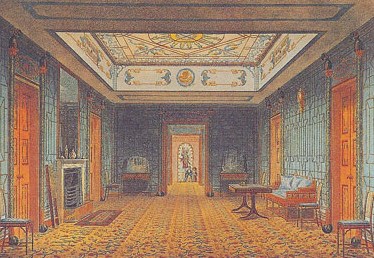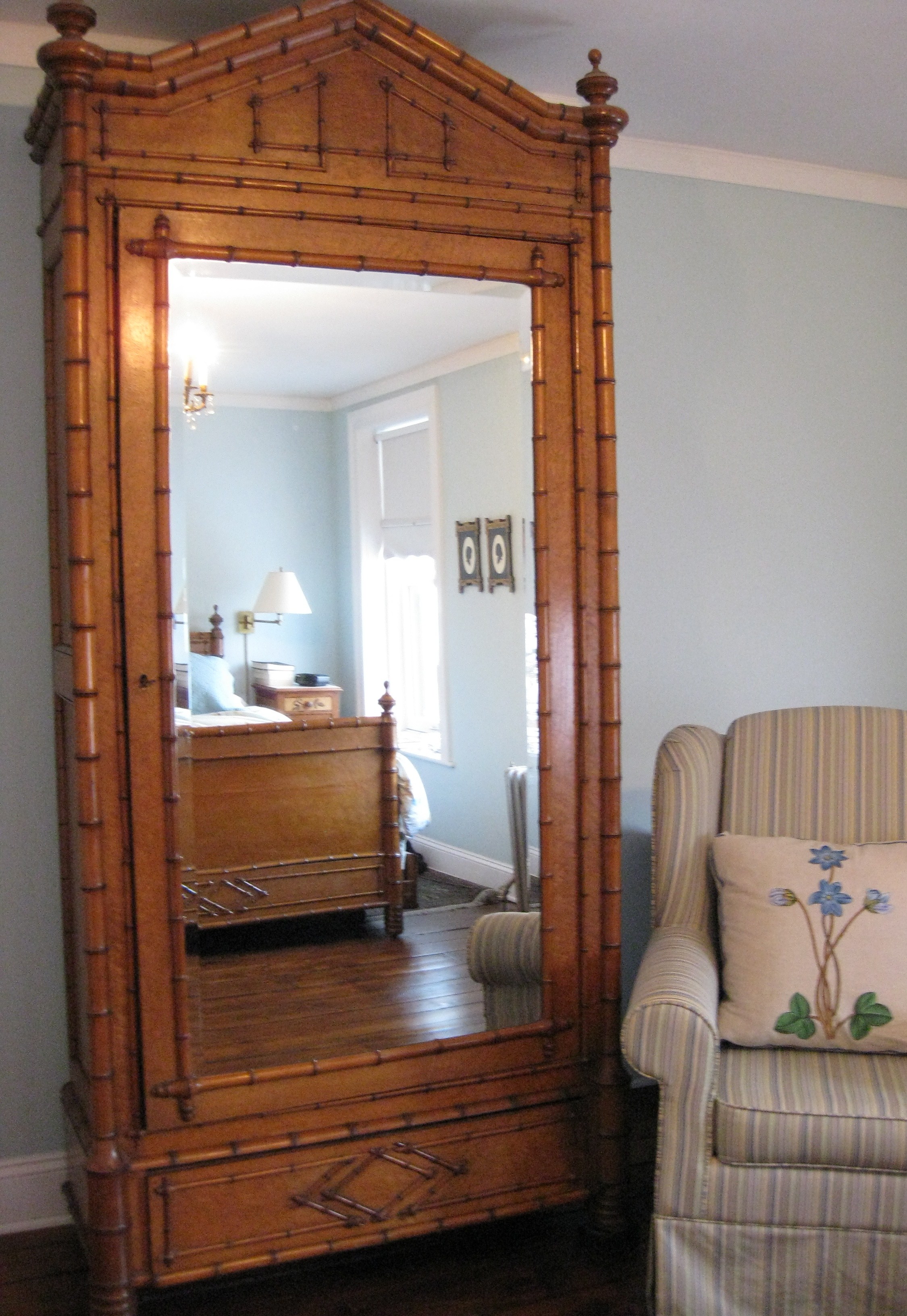
While imported goods from the China Seas trade had influenced furniture design in Europe throughout the 18th century, from Thomas Chippendale to the chinoiserie of Louis XIV at Versailles, the popularity of Asian inspired furniture and design reached a peak with the John Nash designed Royal Pavilion at Brighton, completed by the Prince Regent between 1817 and 1822. Furniture designed to resemble bamboo had appeared about 1750 in England and it was used extensively throughout the Pavillion. But by the 1840s, Brighton – both the place and its related design – was out of style.
Fast forward a few decades to the London International Exhibition in 1862, the Exposition Universelle of 1867 in Paris and the 1876 Centennial Exposition in Philadelphia, all of which created a craze once again for all things exotic and of Asia, particularly Japan, as it had just been opened to the West in 1854. Bamboo furniture had a quirky lightness that was a real counterpoint to the heavy Rococo Revival styles of the early Victorian era. An industry making “faux bamboo” furniture sprang up, as real bamboo was only suitable for very lightweight pieces. Golden stained birds-eye maple and pine were shaped to resemble bamboo stalks as the decorative detail on more substantive pieces. Large suites of furniture, particularly for bedrooms, including beds, armoires, wash stands, night tables, chairs, etc., were manufactured in great numbers in England, France and America. According to a 19th century decorating magazine, their characteristics made them perfect for furnishing “morning rooms, bed chambers, summer houses, and cottages.” R.J. Horner of New York City produced some of the finest examples made in America.
Antique faux bamboo continues to be extremely desirable in the furnishing of vacation homes today. This Southampton bedroom, designed by the late Jed Johnson for Maureen and Marshall Cogan, has long been a talisman room for me. It has one of the most beautiful groupings of faux bamboo, including a number of R.J. Horner pieces, such as the dressing table and chairs. For all the elaborate detail on the furniture, the simplicity, calmness and lightness of the room makes it look like floating on a cloud. The owners wanted their country house to feel “nondecorated” – to be soft and cozy, informal, with nothing off-limits to grandchildren, in the true spirit of a Hamptons great house.
This is the other side of the room. In order to keep all the detail, I did not join the photos. Note the simple pale upholstery and the cheval mirror, which is a particularly fine and rare piece.
Here’s a compressed view of the whole room. The bed is what I call the “English” shape – with rectangular detail along the headboard. I cannot decide if the bed is a reproduction as it looks to be king size, but it is so finely made that I can’t be sure.
Unfortunately Jed Johnson died in the prime of his life and career on TWA Flight 800 to Paris in 1996. Architectural Digest has a poignant memorial to him written by Paul Goldberger, in which he writes, “Johnson seemed always to be able to hear the objects that he loved speak.” I just love that idea!
I always find this Upstate New York home and bedroom a bit unexpected as it belongs to avant-garde American poet John Ashbery. Why a modern poet shouldn’t live in a William Morris papered 1894 Victorian I can’t really say. But the pairing of contemporaries – the arts and crafts wallpaper with the faux bamboo bedroom set – is a perfect combination and a cheery mix of rugs and objects adds to the appeal.
Rosanne Wasserman has written a great personal account of John Ashbery’s home on Rain Taxi, which has many additional, less styled photos of the house and as shown below, the guest bedroom. Wasserman writes, “I found John’s house a perfect antidote for what I like least about museums: that they are not lived-in spaces. John’s house, filled with objets d’art and arranged into subtle, funny, and magnificent scenarios, is also always a place where people live and visit, sleep and dine, watch TV, wash up dishes, sit in chairs. Long may they do so.” No way to say it better than that.
For a house that falls stylistically somewhere between the two above, I turn to Joan Davidson’s Hudson River manse Midwood, featured in Martha Stewart Living. Here, a pair of faux-bamboo twin beds that were found at the Armenia Church Auction are part of a set of 8 pieces. They were also made in 1888, the same year the house was built. This set is ebonized and it makes a strong counterpoint to the richly colored paisley in the bedding and rug. Warm white beadboard walls complement.
The dressing table has a lovely form.

Kevin Sharkey (a powerhouse behind the whole Martha Stewart brand) writes in his Home Tour column about the house, “I believe that a truly beautiful room is one that hasn’t been decorated at all, but rather considered…There are no absolutes. You just have to be inspired, passionate and informed. Then you take it and make it your own. That’s really where beauty comes from.” Many other photos of this beautiful property can be found there.
Besides sets of antique faux bamboo furniture, these homes have something innate in common. Whether created by designer or homeowner they are all somewhat undecorated and fluid. Wasserman writes about her view of the Ashbery home as “only one stage in the evolution of his house, some rooms of which have, since then, been further embellished, or reimagined, or pulled apart and are still being put together.” Cogan says about her Southampton home, “These are living places, and they need fussing with.” I don’t have the entire article on the Davidson house, but I am somehow sure she’d say something similar. I find it slightly ironic that such spaces have “matched” bedroom sets, as little else in these houses is “matchy.” In general, matched furniture sets are not a look that I like, nor the current mood in decorating. But somehow, groupings of faux bamboo just work.
As you might expect, Martha Stewart Living has featured bamboo and faux bamboo many other times as well. This charming green room was an in-house style feature, not a real residence, but I love some of the details, like the curtain valances, sheers and bamboo matchstick blinds. It feels exactly like a summer-house should. This headboard has the “French” shape with two crossed bamboo poles in an inverted V and small newel posts at either end and a straight footboard. It is very common to see French armoires with the same shape too.
This side view shows the raised bamboo decoration found on the side rails.
Here is a view of an antique French armoire in a Brooklyn bedroom of my design. While the bed can be partially seen reflected in the mirror, the inverted V of the headboard is cut off. You can really see the beauty of the birds-eye maple on this armoire. John Robshaw hand painted pillow on the chair.
In this bedroom by Peter Dunham, featuring his hemp and cotton fabric “Jaipur” on the walls, curtains and bed coverings, we can see a very similar French maple bed, only larger, perhaps a double. There is a dresser and a mirror too, although they do not look antique.
He shows an additional view on his website, with the bed against a different wall. Faux Bamboo pieces also look wonderful with Indian block prints and crisp white linens – they play off the “British Colonial” feel.
Here is a similar bed in a room designed by Martyn Lawrence-Bullard for Nick Steyne. This bed and nightstand are not antique – they are his design. Again, there are Indian block prints and white linens.
But this pine bed in another room by Martyn Lawrence-Bullard does look to be antique. Here the bed and room are dressed very differently, with a formal french toile, ticking stripe and paisley coverlet. Perhaps little too formal to live with all the time, but I would love to sleep there for a few nights, imagining I was in France.
While I love the antique beds, sizing can be an issue. Twins tend to be somewhat standard, but most of the larger size beds are US double size at best. They can be converted to queen or another option is to use only the headboard and not the side rails and footboard, both of which I have done. For those who don’t relish all the hassle or cannot live without their king size bed, there are many reproductions on the market, such as the one in the first Martyn Lawrence-Bullard photo and those following.
Starting at the top end of the market, here Suzanne Kasler uses a Michael Smith bed from his line with Jasper Furniture in a bedroom she designed in Atlanta. I don’t know the list price on this, but I imagine it to be hefty.
Leonards offers this meticulous copy of a 19th century English bed resized for the modern home. A king retails for $8300 and there is a matching marble top stand.
The Williams Sonoma Hampstead bed retails for $3550 for a king size. There is a matching nightstand and two different dressers and it also comes lacquered in white.
And of course Martha made one in her furniture line for Bernhardt called “Bali Coast,” which listed for around $1500, but unfortunately seems to be out of production. Craig’s List anyone?
.
But before rushing out to buy a new set, I heartily recommend searching out the antique pieces. While dealers in the Hamptons keep a steady supply around, they often come with big price tags. On the other hand, there are quite a few dealers who import large containers from France, filled with reasonably priced beds, armoires and night stands. Or you can always use it as an excuse to visit les puces….
Image credits: 1. artrepublic.com, 2-4. Architectural Digest, November 1990, photo credit: Scott Frances, 5. Architectural Digest, June 1994, 6. Rain Taxi, photo credit: Ahndraya Parlato, 7-8. Martha Stewart Living, September 2001, 9-10. Martha Stewart Living, date unknown, photo credit: Simon Watson, 11. R. Michaelson, 12. House Beautiful, November 2010, photo credit: Victoria Pearson, 13. Peter Dunham, 14. Elle Decor, December 2005, photo credit: Tim Street-Porter, thanks to So Haute, 15. Martyn Lawrence-Bullard, 16. House Beautiful, April 2008, photo credit: Frances Janisch, 17. Leonards, 18. Williams Sonoma Home, 19. Bernhardt















